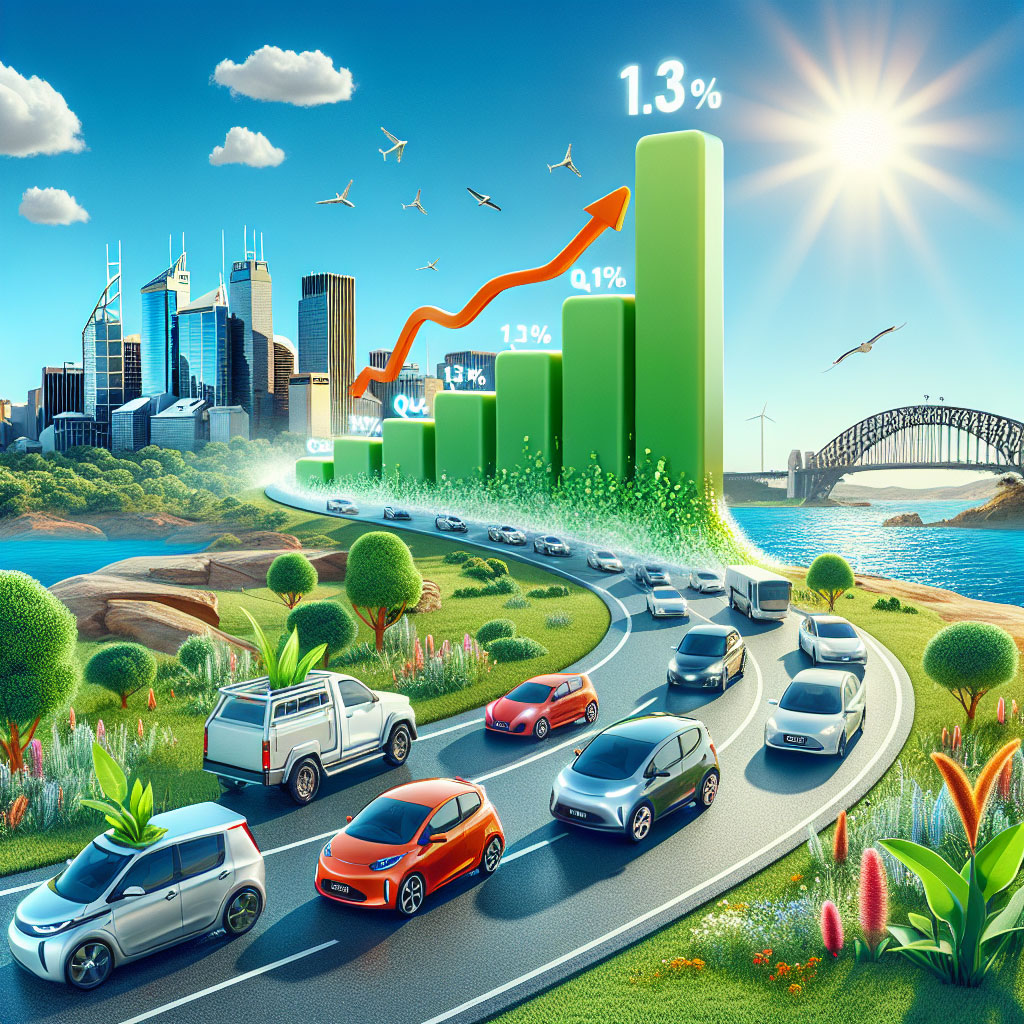
Australia’s electric vehicle market is accelerating into the mainstream. In Q2 2025, EVs captured a record 13.1% share of all new car sales, with 41,146 deliveries for the quarter – up 37% year-on-year. Battery electric vehicles (BEVs) remain the backbone of the transition, while plug-in hybrid electric vehicles (PHEVs) posted a standout surge as buyers and fleets broaden their electrification options. New South Wales and Victoria continue to lead on volume, while the ACT remains the national front-runner for EV penetration.
Key sales figures at a glance
- Q2 2025: 41,146 EVs sold, equal to a 13.1% share of new car sales
- Q2 2025: 29,244 BEVs sold, reaching a 9.3% market share
- Q2 2025: 11,902 PHEVs sold, reflecting rapid growth in this segment
- H1 2025 (Jan-June): EVs exceeded 12% of all new vehicle sales nationwide, up from 9.6% in H1 2024
Where EVs are growing fastest
- Australian Capital Territory (ACT): The nation’s leader in EV penetration, with approximately 21.08% of new vehicles sold being electric
- New South Wales (NSW): The largest market by volume, notching 9,117 sales in Q2 2025
- Victoria: Close behind NSW with 8,638 sales in Q2 2025
- Queensland: A standout performer with nearly 80% growth in Q2 2025 versus the prior year
What’s driving the surge in 2025
- New Vehicle Efficiency Standard (NVES): Australia’s first-ever fuel efficiency standard commenced in 2025. It sets progressively tighter emissions caps for new light vehicles through the second half of the decade, encouraging carmakers to prioritise EVs and lower-emission models for our market.
- Model availability and sharper pricing: A wider spread of price points – from sub-$40k city EVs to family SUVs – is drawing in mainstream buyers. Competitive pricing from established and new entrants has put downward pressure on drive-away costs, improving total cost of ownership for households and fleets.
- Fleet and novated lease demand: The federal Electric Car Discount (FBT exemption) continues to underpin strong novated lease and fleet uptake for eligible BEVs. PHEVs benefited from a rush of orders ahead of the policy change that removed new PHEVs from the FBT exemption from 1 April 2025 (with grandfathering for eligible pre-1 April orders).
- Infrastructure build-out: State-backed networks (including the WA EV Network and the Queensland Electric Super Highway) and federal programs such as the Driving the Nation Fund are expanding highway and urban fast-charging coverage. Opening more Tesla Supercharger sites to non-Tesla EVs has also added useful capacity in key corridors.
- Policy continuity: The Electric Vehicle Council and industry stakeholders continue to stress the importance of maintaining incentives and the NVES framework to sustain momentum and give manufacturers confidence in long-term supply.
Market trends to watch
- PHEVs as a bridge technology: PHEVs gained share in Q2 amid broader choice in family SUVs and utes. They are appealing to drivers seeking electric commuting with combustion backup for longer regional trips.
- Family-first formats dominate: Australian buyers are gravitating toward medium SUVs and crossovers. Compact BEVs retain an important role as value leaders, while premium EVs continue to showcase technology and safety advancements.
- The maturing used EV market: As more early-model BEVs enter the second-hand market, buyers are gaining access to lower entry prices with long battery warranties still in play. This deepening ecosystem supports broader adoption beyond early adopters.
- Charging gets more convenient: More highway fast chargers, suburban hubs, and kerbside projects are addressing range anxiety and apartment-dweller access. Workplace charging is becoming a meaningful differentiator for employers.
Policy and incentives snapshot
- Federal NVES: In force from 2025 for new light vehicles, with targets tightening annually through the decade. Expect continued model diversification and improved supply as carmakers align local line-ups to the standard.
- Electric Car Discount (FBT): BEVs (and certain low-emission vehicles) under the luxury car tax (LCT) threshold remain eligible for the fringe benefits tax exemption under the Electric Car Discount. PHEVs ordered from 1 April 2025 are no longer eligible, with limited grandfathering for earlier orders.
- Luxury Car Tax thresholds: The higher LCT threshold for fuel-efficient vehicles reduces tax pressure on many EVs compared with equivalent petrol models, further supporting affordability in the premium segment.
- State and territory measures:
- ACT: Zero stamp duty for ZEVs and generous registration concessions; strong public charging roll-out.
- QLD: Ongoing network expansion via the Electric Super Highway and targeted grants.
- SA and WA: Co-funded fast-charging networks are now covering key regional routes.
- NSW and Victoria: Direct purchase rebates have ended, but residents may still benefit from discounted registration, toll concessions or local charging grants.
Note: Eligibility criteria and program budgets change; always check current state websites before purchase.
Affordability and ownership costs
- Upfront prices are trending down in key segments, particularly for compact and small family BEVs.
- Running costs are typically significantly lower than comparable petrol models, especially for owners who home-charge on off-peak tariffs or with rooftop solar.
- Servicing costs for BEVs are generally modest due to fewer moving parts, though insurance quotes can vary by model and repairability – worth comparing providers early in the buying process.
Charging and infrastructure outlook
- Highways: Intercity routes and regional tourism drives are increasingly well served, with multi-bay fast chargers appearing at petrol stations, shopping centres and town hubs.
- Urban and multi-unit dwellings: Councils and utilities are piloting kerbside solutions and embedded networks to better serve apartment residents. Building code discussions are encouraging EV-ready wiring in new developments.
- Standards and connectors: CCS2 remains the universal DC fast-charging standard in Australia, simplifying public charging across brands.
Challenges to keep in view
- Apartment and street parking access: More kerbside and workplace charging is needed to support drivers without off-street parking.
- Supply and delivery times: While improving, popular trims can still face wait times as global demand competes for Australian allocation.
- Consumer confidence: Clear communication on battery longevity, resale values and charging etiquette will remain important as new buyers enter the market.
Outlook for the rest of 2025
With the NVES now in effect, the momentum from Q2 is likely to continue through the back half of the year. Expect a broader mix of affordable BEVs, continued strength in PHEVs within family SUV segments, and more regional charging links coming online before the holiday travel period. Stable policy and steady infrastructure deployment will be the key ingredients for pushing EVs beyond a consistent mid-teens market share.
Conclusion
Australia’s EV market is no longer a niche – it’s a fast-growing pillar of the auto landscape. A record Q2 2025, broad-based gains across states, and stronger infrastructure support point to a durable shift in buyer preferences. With policy certainty via the NVES and increasingly competitive model line-ups, the path to mainstream electrification is set. Keeping incentives consistent, strengthening charging access for apartment dwellers and regional communities, and supporting fleet transitions will determine how quickly EVs progress from strong growth to dominant market share.
Frequently asked questions
What is the New Vehicle Efficiency Standard (NVES)?
NVES is Australia’s national fuel efficiency standard for new light vehicles that commenced in 2025. It sets progressively lower emissions caps for carmakers, encouraging the import of cleaner vehicles, including BEVs and PHEVs. Non-compliance can attract penalties, so manufacturers are expected to increase EV supply.
Are PHEVs still eligible for the FBT exemption?
From 1 April 2025, new PHEVs no longer qualify for the FBT exemption under the Electric Car Discount. Some vehicles ordered before that date may be grandfathered under transitional arrangements. BEVs under the LCT threshold remain eligible.
Which states offer the best EV incentives?
The ACT leads with zero stamp duty for ZEVs and substantial registration concessions. Queensland, South Australia and Western Australia are actively expanding charging networks. NSW and Victoria no longer offer purchase rebates but maintain select concessions and co-funded charging programs. Always check the latest state programs for updates.
How robust is Australia’s charging network now?
Coverage has expanded significantly on major highways and in regional centres, with more multi-bay fast-charging sites improving reliability. Urban capacity is growing via shopping centre hubs, energy retailer networks and council-led kerbside pilots.
Do EVs really cost less to own?
Typically, yes. Electricity – especially off-peak or solar – is cheaper per kilometre than petrol, and BEVs have lower routine maintenance needs. Insurance and tyre costs vary by vehicle and driving profile, so it pays to compare.
Should I choose a BEV or a PHEV?
- Choose a BEV if you can regularly charge at home or work and want the lowest running costs and simplest maintenance.
- Consider a PHEV if you do frequent regional trips without ready access to fast charging, but can commute mostly on electricity day-to-day.
What about battery life and warranties?
Most EVs sold in Australia carry battery warranties of around eight years with kilometre caps, assuring a minimum state-of-health over that period. Real-world data suggests modern lithium-ion packs remain durable when managed with sensible charging habits.
Can I road-trip in an EV?
Yes. Planning is still helpful on longer regional routes, but multi-bay highway chargers and improved mapping make intercity travel increasingly straightforward. For remote routes, check charger availability ahead of departure.
About EV Evolution
EV Evolution is the leading online platform dedicated to Australian electric vehicle owners and enthusiasts. We foster a vibrant community, delivering essential EV news and insights, and enhancing user engagement through our innovative, AI-powered chatbot for dynamic discussions. Our mission is to empower Australian electric vehicle owners and enthusiasts by fostering a vibrant, AI-driven online community that connects, informs, and advances the nation’s electric vehicle landscape.




